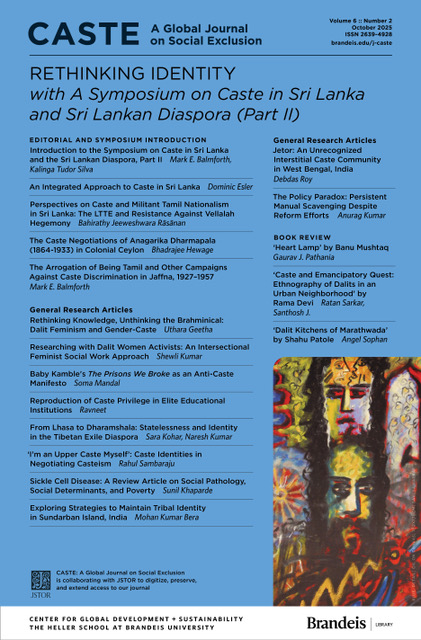The Caste Negotiations of Anagarika Dharmapala (1864-1933) in Colonial Ceylon
Main Article Content
Abstract
Analyses involving Anagarika Dharmapala (1864–1933) and his relationship to caste— rare enough as they are—often mirror conversations on the position of caste in Sri Lanka more generally. Despite the presence of caste and its previous significance in the island’s history, these discussions hold that caste no longer maintains a critical social purpose. Dharmapala’s formulation of Buddhism as an ethnocentric and hegemonic ideology that concealed rather than addressed social inequality within the island’s majority Sinhalese community perhaps also best summarises these narratives. Yet what is lost in these discourses is that caste remained an ever-present feature of Dharmapala’s social vocabulary and for his visions for both the Sinhalese ethnicity and for Buddhism more generally.
This article tracks Dharmapala’s caste engagements and the wider societal implications of his understanding of the phenomenon for Sri Lanka today through analyses of his writings and speeches both in English and in Sinhalese. As this article demonstrates, caste became an important instrument for Dharmapala to distinguish that which was good for society from that which was bad. Of mixed-caste parentage himself, Dharmapala remained exceedingly critical of Sri Lankan caste structures yet curiously respected—if not admired—those in neighboring India. As perhaps the most high-profile Buddhist anywhere in South Asia during his time, Dharmapala had an incomparable influence on publics across the wider region. While dismissing the significance of caste in religious practice, Dharmapala nonetheless accepted its traditional social function with caste reform rather than abolition at the core of his wider societal plans.
Downloads
Article Details

This work is licensed under a Creative Commons Attribution 4.0 International License.
A. CORRESPONDING AUTHOR’S GRANT OF RIGHTS
The Corresponding Author grants to the Journal, during the full term of copyright and any extensions or renewals of that term, the following:
- An irrevocable non-exclusive right to reproduce, republish, transmit, sell, distribute, and otherwise use the Work in electronic and print editions of the Journal and in derivative works throughout the world, in all languages, and in all media now known or later developed.
- An irrevocable non-exclusive right to create and store electronic archival copies of the Work, including the right to deposit the Work in open access digital repositories.
- An irrevocable non-exclusive right to license others to reproduce, republish, transmit, and distribute the Work under the condition that the Authors are attributed. (Currently this is carried out by publishing the content under a Creative Commons Attribution 4.0 license.)
Copyright in the Work remains with the Authors.
B. CORRESPONDING AUTHOR’S DUTIES
- When distributing or re-publishing the Work, the Corresponding Author agrees to credit the Journal as the place of first publication.
- The Corresponding Author agrees to inform the Journal of any changes in contact information.
C. CORRESPONDING AUTHOR’S WARRANTY
The Corresponding Author represents and warrants that the Work is the Authors’ original work and that it does not violate or infringe the law or the rights of any third party and, specifically, that the Work contains no matter that is defamatory or that infringes any literary or proprietary rights, intellectual property rights, or any rights of privacy. The Corresponding Author also warrants that he or she has the full power to make this agreement, and if the Work was prepared jointly, the Corresponding Author agrees to inform the Authors of the terms of this Agreement and to obtain their written permission to sign on their behalf. The Corresponding Author agrees to hold the Journal harmless from any breach of the aforestated representations.
D. JOURNAL’S DUTIES
In consideration of the Author’s grant of rights, the Journal agrees to publish the Work, attributing the Work to the Authors.
E. ENTIRE AGREEMENT
This agreement reflects the entire understanding of the parties. This agreement may be amended only in writing by an addendum signed by the parties. Amendments are incorporated by reference to this agreement.
